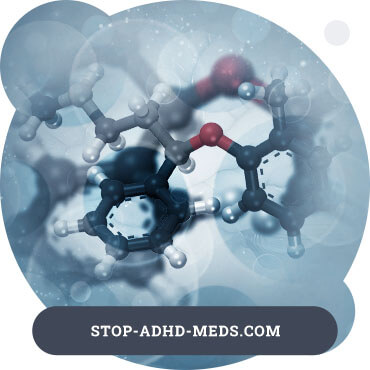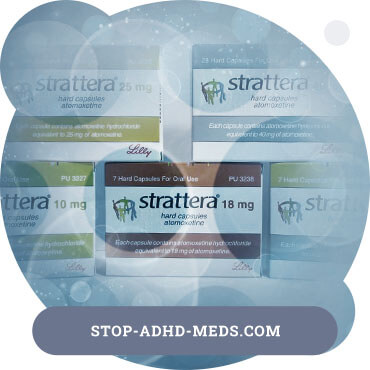Atomoxetine: 90% ADHD effectiveness in a small affordable capsule
Attention deficit hyperactivity disorder (known as ADHD) is a derangement caused by neurodevelopmental disruption during pregnancy frequently manifests during childhood.
This disorder is mainly identified because the children suffering from it have impulsive behaviors, increased motor activity (they hardly sit still) combined by a noticeable attention deficit.
They are children who basically respond in an exaggerated way to normal daily life stimulation (impulsiveness), are restless and find it difficult to focus on a single activity, however simple it may be.
This illness prevalence is 5% almost in the United States, but it may vary depending on the diagnostic studies used if there are or not risk factors associated, the school, family, and social environment in which the child develops, and whether it is about the general population or not. However, it is still the most frequent childhood neuropsychiatric disorder.
One of the most important features this pathology has is the presence of risk factors; these are nothing more than situations or circumstances that could increase a certain population's probability of suffering a disease.

The defining risk factors in ADHD are tobacco, alcohol, or cannabis consumption during pregnancy, birth diseases such as low birth weight, prematurity, or hypoxic encephalopathy, the ADHD family history as well as belonging to unhealthy environments.
To talk about ADHD we need to keep in mind that the symptoms must remain for at least 6 months continuously, must arise before 7-years-old, and must be evident in more than one scenario. It is crucial to differentiate between energetic and talkative from ADHD children, especially since the latter behave wildly at any time, even when they are told to remain calm.
There are currently many treatment options, also, it should not be seen as a mental illness only but globally, as a set of therapeutic measures that together have the main objective of reducing or disappearing symptoms.
Psychology, psychopedagogy, and psychiatry are among the therapeutic options. The latter is the one who finally prescribes the necessary medication that will end the symptoms. Accordingly, within the used drugs, several options can be classified depending on if they stimulate the central nervous system or not: Methylphenidate (MFD) as a stimulant and Atomoxetine as the opposite.
Atomoxetine (Strattera®) is a drug that presents itself as the most effective therapeutic option, with the fewest side effects and the only internationally approved non-stimulant drug to treat ADHD symptoms.
So, what is Atomoxetine really? It is a medication from the central nervous system non-stimulatory drugs group, not amphetamine compounds obtained.
It was approved by the FDA seven years ago to comprehensively treat ADHD and significantly reduce associated symptoms such as impulsivity and motor hyperactivity, of course in conjunction with psychology, psycho-pedagogy, family, and school psychoeducation.
It is a chemical drug characterized by selectively and very precisely inhibiting the reuptake of some neuronal substances called neurotransmitters, these tiny molecules are normally found in our brain, working to allow all our brain functions.
When is consumed, Atomoxetine is responsible for decreasing neurotransmitters levels in our brain which would otherwise be excessively elevated in children with ADHD.
How does Atomoxetine work? Well, it is necessary to separate many points to explain it easily. Our brain is made up of neurons and connections between them called presynaptic and postsynaptic regions, these links are something like little wires that allow messages to be sent from one place to another.
The brain functioning under normal conditions is based on sending information from one neuron to another through neurotransmitters; these molecules trigger a series of fundamental chemical reactions once they reach a neuron to allow thought, memory, language, and speech among other neurological capacities.
We can mention dopamine, norepinephrine (NA), epinephrine, and serotonin among the different neurotransmitters; each one of them has a specific function and abounds in a precise place in our central nervous system.
Now, the ADHD infant brain differs from others since its frontal area is modified (where the human complex functions are made), but why? Because there is a lack of neurotransmitters controls, being the Noradrenaline a symbol.
So, when administered, it travels throughout the digestive system, bloodstream, and finally arrives in the brain where it works. When Atomoxetine gets there, it is precisely in charge of acting on the norepinephrine reuptake presynaptic receptors, inhibiting the storage function.
After this reuptake inhibition, the neuronal norepinephrine levels decrease in the presynaptic region and increase in the synapse area where the neurons converge, improving brain functions, decreasing impulsivity and promoting self-control in ADHD.
Molecularly talking, it has been said that Atomoxetine is similar to several drugs and may also have been mentioned that is Fluoxetine and Reboxetine analogous (both antidepressants) however, they cannot be compared since is scientifically confirmed that these drugs differ both in their function as in many forms.
One of the drug's benefits is that it does not interfere or interact with the necessary brain functions neurotransmitters such as dopamine, serotonin, adrenaline, or tyrosine, and compared to other brain-acting drugs it has fewer side effects. A sensation!
What do I need to know before taking Atomoxetine?
Atomoxetine has certain contraindications or situations where its administration is not recommended, like any medicine or substance we use.
The first essential thing to do must go to a medical professional; this action cannot be replaced or postponed. Besides, it is necessary to inform our medical doctor about any one or more diseases, whether it is a condition from many years ago or a newly diagnosed one, so failures due to misunderstandings can be avoided.
According to the above, you should not take Atomoxetine in allergies or hypersensitivity to Atomoxetine or its derivatives, if you have taken drugs such as phenelzine in recent weeks, this is a monoamine oxidase enzyme inhibitors (MAO) related medication, if you have suffered or suffer Glaucoma or if you suffer from heart conditions that cannot tolerate heart rate increases.
In this order of ideas, other circumstances are described where its use is not recommended, such as in brain diseases like brain aneurysms, blood vessels architectural diseases such as uncontrolled hypertension, or adrenal gland problems such as pheochromocytoma.
| BRIEF – ADHD-IV | BRIEF-E - EDAH | |||
|---|---|---|---|---|
| Subscales and indexes | Attention deficit | Hyperactivity | Attention deficit | Hyperactivity |
| Inhibit | .42** | .73** | .05 | .71** |
| Shift | .39** | .59** | .07 | .34** |
| Emotional control | .39** | .56** | .12 | .59** |
| Initiate | .55** | .36** | .47** | .12 |
| Working memory | .60** | .44** | .47** | .21* |
| Plan/Organize | .63** | .33** | .55** | .22* |
| Organization of materials | .49** | .15 | .26** | .29** |
| Monitor | .54** | .45** | .39** | .39** |
| Behavioral Regulation Index | .44** | .70** | .10 | .68** |
| Metacognition Index | .67** | .38** | .62** | .32** |
| Global Executive Composite | .63** | .60** | .47** | .58** |
| Note: Clinical Sample. BRIEF (N = 100), BRIEF-E (N = 125) * p < .05; ** p < .01. | ||||
Drug interactions: The real point to be cautious about
It is necessary to know how it is the human body's metabolism and distribution to comprehend how this drug interacts with other substances.
After oral capsules ingest, Atomoxetine travels through the digestive system being quickly or slowly absorbed (depending on the speed of the person's metabolism), reaching a 60 to 90% blood plasm availability in a few hours.
Once traveled through the bloodstream it meets the liver, where almost all drugs are entirety metabolized and where almost 100% of enzymatic reactions happen.
Enzymatic reactions are nothing more than necessary chemical reactions to break down all the substances we absorb, from the moment we eat until we breathe.
These reactions are identified by being promoted by catalytic substances called enzymes, they are somewhat like aid soldiers during the annihilation of the things we ingest.
So, the Atomoxetine metabolism happens the moment it reaches the liver, where it goes through several chemical reactions and joins to the CYP2D6 enzymatic system, knowing that this is not the only medication binding to this system.
Drug interactions occur when drugs that share precise enzymatic systems are administered at the same time, in this case, when ingested drugs that bind the CYP2D6 enzymatic system.
Other medications with this same metabolic pathway are beta-blockers such as Metoprolol, Carvedilol, Atenolol, or Timolol; tricyclic antidepressants such as Imipramine and Amitriptyline; Selective serotonin reuptake inhibitor medications like Fluoxetine or Paroxetine to name a few.
Atomoxetine can also interact with other drugs such as Bupropion, Mirtazapine, and Venlafaxine, as well as influenza syrups or any indicated medications, especially antitussive bronchodilators such as Dextromethorphan.
Drug interactions have also been described with pain-reducing narcotics opioids derived such as Codeine, tramadol, or oxycodone.
It is recommended to decreased Atomoxetine dosage when administered concomitantly with antipsychotic medications such as Haloperidol, Risperidone, Perphenazine, Remoxipride, or Aripiprazole as well as antiemetic substances against nausea and vomiting such as Ondansetron or Tropisetron.
Under no circumstances should Atomoxetine be administered in conjunction with the aforementioned drugs, otherwise unwanted signs and symptoms can happen related to mixing chemical reactions between drugs.
Likewise, this medicine associated with the monoamine oxidase inhibitor drugs (MAOI) is not indicated, especially because these elements also inhibit a brain enzyme acting as antidepressants. Among them are Fenelzina, Tranilcipromina, Iproniazida, Moclobemida, and Toloxatona.
If treatment with Atomoxetine or MAOIs is essential, there must be a 2-weeks interval between the administrations of one drug, so the body can excrete the excesses from any drug metabolism.
To date, no severe toxicity reactions linked with this drug have been described, although it is not suggested under any circumstances to associate it with any of the aforementioned medications, so its ingest is very safe.
Possible Side Effects
Side effects are harmful or unwanted results as a consequence of consuming certain substances. Most of the things we consume have unfavorable effects but only some more noticeable than others.
In this particular, Atomoxetine is not an exception to the rule and also has, like all medicines, some side effects, although this does not mean that you must necessarily manifest them all.
These sequelae can be classified depending on the frequency in which they appear, thus having the very frequent, frequent, infrequent, and rare.
Common side effects are known as those that develop in up to 1 in 10 children. Common unwanted outcomes that may occur in children include headaches, nausea, vomiting, diarrhea, poor appetite (not hungry), feeling generally unwell, drowsiness (sleeping all day), increased heart or respiratory rate, dry mouth, and trouble waking up early.
This does not mean you or your child will suffer from them, although these side effects are curiously common. So far, testimonials from many parents say that their children have experienced very little or no side effects at all.
Frequent side effects are explained as those that usually occur in up to 1 in 20 children, including irritability (restlessness), falling asleep problems, extreme sadness or depression, despair feeling, anxiety episodes, nervous tics debut, temporary pupillary dilation, dizziness, nausea, vomiting, defecation problems (constipation), appetite loss, or skin rashes.
In this category stand out too swelling or skin redness, the feeling of laziness or extreme tiredness (fatigue), chest pain, muscle pain, weight loss, tremors, or indigestion.
Regarding infrequent side effects, these are defined as those that appear in up to 1 in 100 patients and detailed as: fainting, tremors, intense and prolonged headaches (migraine), visual disturbances such as blurred vision, and rare skin sensations such as burning or redness without apparent cause.
This same classification also includes nervous tics, decreased muscle strength (feeling weak), palpitations (heartbeat becomes noticeable), seizures, tingling or itching sensation, increased sweating, and muscle cramps.
As for the rare side effects (those that occur in up to 1 in 1,000 children), numbness and pale color of the hands and feet are mentioned due to blood circulation problems known as Raynaud's phenomenon, intestinal transit lessening, urinating problems or painful urination, decreased urinate day-time output and groin region pain, especially in men.

Other authors also describe certain growth problems, especially when indicated during the children growth stage, these problems may be correlated with a reduction in weight and height, however, they explain that these growth problems are in many cases due to other reasons and not linked to the use of Atomoxetine and, if it is due to this medication, it can be recovered as the treatment continues.
Being appetite the first and most important issue for parents, it is vital to understand that during treatment with Atomoxetine, lack of appetite occurs within hours of the drug's effect, recovering in the late afternoon.
It is clearly necessary to make sure that the child had an ideal and full breakfast since this meal represents almost 40% of nutritional contribution during the day.
Indeed, it is also essential to make appetizing but small snacks so the child can eat during the afternoon, as well as reducing the medication dosage on weekends to allow the child to play, be more active, and less under the medicine influence.
Zinc compounds or dietary stimulants can be added to the menu to prevent these unwanted outcomes if preferred. Likewise, is vital to consult your trusted specialist immediately if you or your child experiences any of these mentioned side effects.
Finally, it is also recommended to rigorously follow the specialist's prescribed indications to avoid undesired effects, complying with the appropriate hours and doses.
Other uses: In what other situations can Atomoxetine be used?
Although we mentioned at the beginning of this text, the main indication of Atomoxetine today is for attention deficit hyperactivity disorder, but it can be used in other situations too.
As stated in this text opening, the actual Atomoxetine main indication is in the attention deficit hyperactivity disorder treatment, but unofficially, it can be used in other situations too.
ADHD is known as a slow-onset chronic disease with a poor presentation during the first three years of life but becomes more apparent as time passes.
This disorder was first described in 1902 when the pediatrician George Still detailed 23 children finding out that they had moral deficiencies and a certain degree of intellectual ailment, reporting them as enraged, disobedient, and self-destructive selves. But he was a little bit wrong.
To talk about ADHD nowadays, you need to meet a few clinical criteria:
- Lack of attention (inattention): making it difficult to focus on a single activity or task. Children often feel bored or tired while performing a certain task or are easily distracted when they do activities or games that interest them.
- Impulsive behavior (impulsiveness): It is shown as the lack of self-control before other's reactions or different opinions. They are usually aggressive and do not tolerate boredom.
- Hyperactivity: It is the inability to stay still in the same place, they seem unable to stop moving and usually have nervous tics such as legs or hands repetitive movements. They tend to get up frequently from their desk in classes or to disobey orders or punishments.
In ADHD, its use is justified with several doses, always understanding that each patient is different and needs individual doses.
In children under 6 years 0.5 mg / kg PO once daily Then, the dose should be increased gradually little by little every 3 or days, always depending on the child's tolerance.
In large children weighing more than 70 kg the dose must be higher and should start with 40 mg PO once a daily. Its presentation can range from 10 mg to 100 mg capsules, varying between 18mg, 25mg, 40mg and 80mg, so there is diversity in terms of their presentations.
Atomoxetine is also indicated in adults with ADHD; in this case, the 40 mg PO dose is used once daily and should be increased as treatment progresses and according to the patient tolerance.
It is normal for children to present characteristics similar to those already mentioned during childhood, however, a child with ADHD differs from others because there is a significant decline in various life areas, and not only this, if these symptoms are not treated timely they can harm the next life stages workplace and society.
Among the other uses of Atomoxetine, its direction is also described in executive motor diseases such as Parkinson's (PD), a chronic and degenerative disease that progressively attacks the execution of body movements, especially those that require higher skill like subtle moves.
This condition generates an enormous degree of disability over time, depression included. Atomoxetine has been indicated in certain PD cases when associated with depression, however, despite many scientific studies; its efficacy has not yet been proved.
In this order of ideas, other indications have been discussed, such as in the Narcolepsy with cataplexy case. This is described as a neuropsychiatric disease defined by excessive sleep and loss of body posture (fainting).
Narcolepsy is defined as extreme tiredness during daylight hours where we should not be sleepy or tired usually; and cataplexy as the inability or fast loss of body posture with a sudden ground fall, which can be improved by laughing attacks without memory loss.
Although this is a very rare disease, it frequently influences kids during childhood. Besides, sleep paralysis, hallucinations or depression can be associated with the above symptoms. Although its cause has been extensively studied, the reason why it happens is still unknown.
This ailment treatment is, like in ADHD, multidisciplinary, and requires daily life adjustments such as implantation of naps, family-school psychoeducation, as well as the indication of pills to decrease symptoms where Atomoxetine plays a heroic role.
In this particular, Atomoxetine is indicated to improve cataplexy symptoms by increasing brain levels of amines, such as norepinephrine, to finally promote brain activity.
Although many specialists have routinely used reporting favorable results, its use in this disease has not yet been approved by the FDA.
At the same time, this medication has been used off-label (without official approval) in other mental disorders reporting controversial results, some researchers speak of beneficial results while others do not.
It has been used in depression, eating disorders, anxiety, cognitive-behavioral disorders, substance addictions, and even mood disorders.
Advantages of using Atomoxetine: Why take Strattera?
Compared to the other drugs indicated in ADHD Atomoxetine is an innovative and recent medication, so it provides better results, produces fewer side effects, and interacts to a lesser extent with other drugs than the rest.
This remedy represents a first-line attack medication in the ADHD treatment as well as MFD and can be used both in children (as long as they are over 6 years of age), teenagers and adults, which it means at any stage of life because their tolerance has been widely studied and exhibited even in the elderly.
Furthermore, as it is a medicine that does not stimulate the central nervous system, it can be used safely in children suffering from other neuropsychiatric disorders at the same time.
In addition to this, there is a 30% and 40% probability of ADHD patients will not respond to the Methylphenidate's usual medication, being the indication of Atomoxetine essential and necessary and generally patients respond favorably when this change is made.
When we balance Atomoxetine with MFD, several comparative scientific studies found that both drug efficacy is similar and reaches almost 90%, valuable data because MFD has been for years a first-choice medication in ADHD that cannot always be indicated when there are circumstances or comorbidities associated.
On the other hand, it is a cheap medication that makes up only a few dollars' expenses to pay for per monthly treatment, having excellent cost-effectiveness and beneficial impact on the family.
We believe it is essential to emphasize that this medicine administration is not a game or a situation from one moment to the next, to reach its prescription (mainly in ADHD) it is necessary to go to a mental health specialist since if you do not strictly comply with all the clinical criteria and all areas covered by this therapy, treatment may fail.
It is always required to incorporate parental and school psychoeducation with psychological behavioral therapies, psychopedagogy, and finally medication, ALL of these tools being stars in the healing plan.
Articles
ADHD: Considering it more as a disorder than as a disease
The way humans grow and transform is splendid; something fascinating to admire, however, our body goes through many growth phases as well as all our organs to reach what we are today.
Neurodevelopment is probably the most fascinating and important process during our initial conformation. This goes from the moment of conception and does not stop until death.
Neural development is thought to play a fundamental role when it comes to psychiatric and neurological diseases, since there may be errors during this susceptible uterine process that could exhibit unwanted disorders.
Our nervous system composition is based on the brain, cerebellum, and brainstem, all of this contained in a cavity known as the skull, where everything learned from birth to death resides; language, emotions, feelings, memories, thoughts, memory, etc.
It is necessary to remember neurodevelopment phases to speak of attention deficit hyperactivity disorder in order to understand how the growth mistakes occur.
Neurodevelopment can be phases-divided according to the compromised systems, always keeping in mind that it begins at the conception moment (once the sperm and ovum fertilized) and continues throughout life.
The neurological evolution phases related to structures and functions are; anatomical and motor development, environment identity, language and knowledge neurodevelopment.
The latter is the hero determining the language and allowing us to recognize the environment around to identify us with it during the first 10 years of life.
As language is the main tool that allows us to communicate with the outside world it is easy to recognize disorders that impair that ability during these learning-years, such as autism and attention deficit hyperactivity disorder, known by its acronym ADHD.

Attention capacity plays a primary role in our lives by allowing us to focus on mental activity to perform a task or choose outside stimulation to avoid possible distractions during an activity.
Being able to pay attention allows us to be more effective in all our daily tasks, from studying, coloring, cooking, listening to music or watching a movie, otherwise we would live in dismay at how overwhelming the world around us can be.
Attention deficit hyperactivity disorder (ADHD) is a neurodevelopmental ailment that affects the ability to keep attention and facilitates hyperactivity and impulsivity. It first appears in childhood but can be diagnosed at any time in life.
This is not a new society's problem. ADHD has been around since the 1700s when the physician Alexander Crichton relates in one of his works people with similar traits to ADHD, giving them the name of mental restlessness; however, it was not until 1902 that George F. Still described it for the first time as a frequent children disorder, and depicted them as kids with normal intelligence but moral deficiencies.
This is considered a psychiatric disease, but when early treatment is started, many social and occupational consequences can be prevented allowing an effective and functional life.
It is currently still considered a public health problem as it is extremely frequent (5% prevalence in the United States), which occurs especially in early life stages (childhood) and a chronic process that lead to a certain disability degree affecting the rest of the behavioral spheres.
Prevalence means the population's risk of suffering from certain diseases expressed in percentage. It may diverge depending on the diagnostic criteria used, the presented symptoms predominance, gender, growth stage (age) if there are any related diseases, the study methods used, and whether it refers to the general population or not.
We have to discern between three behavioral patterns when we talk about ADHD, according to ICD-11 they are:
- ADHD associated to inattention.
- ADHD associated to impulsive behavior and increased activity.
Mixed ADHD, combined presentation (may include both inattention and impulsive behavior or increased motor activity).
Lack of attention (inattention) is understood as the child's inability to maintain mental processes on a single task or activity, in an easily way; he gets instantly distracted. While impulsive behavior (impulsivity) is an excessive erratic response to certain stimulation, this response is generally aggressive without any premeditation or analysis.
When it comes to hyperactivity it is a noticeable increase in motor activity. Although it is normal for children to be very active and playful during childhood, hyperactivity linked to a neurodevelopment disorder is not. This increased movement or lack of self-control to stay calm becomes more noticeable when instructed to obey an order and unable to remain still.
Shortly, the important characteristics to be able to talk about ADHD are that the impulsivity or attention deficit degree is greater than what we can consider normal during childhood and these aspects must be evident in more than one environment, whether it is family, school or individual.
In addition to this, there are two additional points to keep in mind: symptoms appear before 7-years-old and they remain for at least 6 months.
Plus, this disorder cause is not known as a single one but a multifactorial one and risk factors are involved.
Risk factors are circumstances or situations that increase a person's possibility of illness, they apply in all diseases, and ADHD is no exception rule.
Heredity, ADHD family history, school, family or socially unhealthy environments, and even low birth weight, premature birth, or perinatal diseases are defining causes in this disease.
The fine line between typical and atypical behavior: How to recognize ADHD?
It is usually during childhood for infants to play, shout, have a little lack of concentration, get excited, and even be impulsive sometimes, but when it comes to kids with ADHD, these behaviors become persistent and can last until youthfulness and until adulthood in advanced cases.
Parents should be attentive to each child's behavior during this important phase and, at the time of any irregularity, be able to decide whether to consult with a mental professional or not.
Among the symptoms that a child with ADHD can show are:
- Frequently forgetting tasks, toys, pencils, notebooks, clothes, or activities, even the easiest tasks such as picking up a toy.
- Talk wildly and for a long time. Children are usually talkative but when it comes to a child with ADHD they tend to speak all the time and even interrupt conversations.
- Inability to carry out orders.
- Inability to stay in the same position or in the same place.
- Tends to reply before people finish asking questions.
- They often leave their seats-school, even when instructed by teachers to remain seated.
- Often seem not to listen when they are being spoken to.
- They most of the time refuse or run away from any task that requires sustained mental effort such as: drawing, writing, doing homework, collaborating with housework, etc.
Although manifestations can change between each child and even between each life stage, these are the most frequent and the most evident when making the diagnosis.
Children are naturally like this; hyperactive, happy, restless, or competitive, and it can be difficult for a parent to detect these symptoms, however, understanding that there is a small limit between normal and abnormal helps a lot deciding when to consult professional health.
Kids who normally get along with their friends at school but behave badly at home or vice versa may have a precise factor problem and should not be considered as ADHD patients since, as we mentioned at the beginning, all these peculiarities should be evidenced in more than one situation.
Treatment: The real family challenge
If you are looking for only one treatment, we must tell you that it is not based on a single step guideline but by being multidisciplinary and requiring the support of indicated psychiatrist medication, psychopedagogy, and psychological therapy.
During this treatment, it is absolutely that both the child and the parents undergo a psychological evaluation since the parents will ultimately represent the most important cornerstone in the fulfillment of the therapy.
We talk of multidisciplinary treatment because it is necessary to associate educational, behavioral, academic, or school factors and the specific drugs use to decrease symptoms.
Psychoeducation is about teaching parents what ADHD means and how it functionally affects their child's life. The more parents know about this disorder, the more possibilities they will have to help their little one.
Among the tasks parents can perform during therapy are:
- Establish clear and concise rules at home and the possible consequences of non-compliance, as well as prizes or rewards that could motivate the child to be obedient.
- Bring child support during school or extracurricular activities, separating it into smaller and less complex steps.
- To avoid unexpected reactions due to lateness, create morning, afternoon, and evening routines that allow the child to predict or precede changes.
- It is important to create a harmonious environment for good activities performance. Suppress annoying noise, games, television shows, or any devices that may the child distract from doing daily activities.
- Motivate them during the achievement of any activity, no matter how small or short it is.
Likewise, numerous studies and professionals recommend applying this guide to schools and extracurricular environment.
Experts confirm teachers should create study routines and activities in the classroom so the child can predict the upcoming situations and avoid anxiety episodes.
Moreover, educators need to motivate the child individually during tasks and divides the classroom into small groups to facilitate teamwork, promote social relationships, and reduce impulsivity.
Pharmacological treatment plays a keystone role related to reducing hyperactive behaviors when psychological therapy is associated. During taking the to-be-mentioned drugs, it is important to have rigorous vigilance to confirm their efficacy.
Stimulant treatments
They are frequently used and are distinguished by their brain level action mechanism based on increasing the neurotransmitters levels such as norepinephrine and dopamine.
This category describes Methylphenidate (MFD), a safe and effective medicine recommended by mental health specialists for almost 60 years.
This can be a long or short-acting medication, the indicated dose could change from 5mg to 10mg per day and may vary depending on the patient's age, weight, tolerance response, and treatment duration but the one who finally makes this choice is the health professional.
MFD has usually slight side effects such as nausea and headache that can improve and even disappear with a minimal dose readjustment.
NON-stimulating treatments
Atomoxetine (Strattera) stands out in this category. It is the NON-stimulating first-line drug, especially when is ADHD nervousness, tics, or anxiety associated.
This medication considerably reduces the ADHD associated symptoms throughout the day evenly, meaning this one of the clearest benefits of Atomoxetine.
The standard dose varies depending on each individual and the treatment duration, being the first ideal dose 0.5mg/kg per day in a single morning shot, and as we already mentioned, the dosage must be indicated by a specialist, similarly to the MFD.
Side effects include headaches, insomnia, fatigue, or irritability, but they are minimal and infrequent and could disappear with a small dosage adjustment same as the first one described.
Other non-stimulant drugs within this same section are related too; Clonidine, Bupropion, and tricyclic antidepressants. They also have a helpful ADHD outcome, although they are not the first medical option.
Yet several studies demonstrate their effectiveness, these drugs are not the medical-practice first choice, so it is necessary to consult its indication first with a specialist.
The parent's participation throughout the treatment is of utmost importance since kids are helpless unpredictable individuals during this age, and do not understand the disarray they suffer from.
The child's school and social performance will depend on their parents to a large extent. They must let their kid know that they can be better individuals through the therapy and that ADHD is not a large scale life-limiting disease or a bully or discrimination matter.
The misdiagnosed or poorly treated ADHD impact in the child's life and later adult could be huge resulting in academic problems related to learning-delays, social struggles leading to isolation, and finally triggering into other mental conditions such as depression, anxiety, or eating disorders.
The ADHD teens or adults consequences go beyond inappropriate behaviors; They could become multiple love partners and failed social selves, tend to be defiant and do not comply with the basic coexistence rules, they can constantly change their work environment due to social relationships failures, and in severe cases, end up in unwanted illegal situations.















